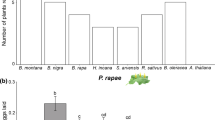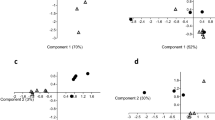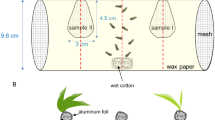Abstract
As it pertains to insect herbivores, the preference-performance hypothesis posits that females will choose oviposition sites that maximize their offspring’s fitness. However, both genetic and environmental cues contribute to oviposition preference, and occasionally “oviposition mistakes” occur, where insects oviposit on hosts unsuitable for larval development. Pieris virginiensis is a pierine butterfly native to North America that regularly oviposits on an invasive plant, Alliaria petiolata, but the caterpillars are unable to survive. Alliaria petiolata has high concentrations of the glucosinolate sinigrin in its tissues, as well as a hydroxynitrile glucoside, alliarinoside. We investigated sinigrin as a possible cause of mistake oviposition, and sinigrin and alliarinoside as possible causes of larval mortality. We found that sinigrin applied to leaves of Cardamine diphylla, a major host of P. virginiensis that does not produce sinigrin, had no effect on oviposition rates. We tested the effect of sinigrin on larval performance using two host plants, one lacking sinigrin (C. diphylla) and one with sinigrin naturally present (Brassica juncea). We found no effect of sinigrin application on survival of caterpillars fed C. diphylla, but sinigrin delayed pupation and decreased pupal weight. On B. juncea, sinigrin decreased survival, consumption, and caterpillar growth. We also tested the response of P. virginiensis caterpillars to alliarinoside, a compound unique to A. petiolata, which was applied to B. oleracea. We found a significant reduction in survival, leaf consumption, and caterpillar size when alliarinoside was consumed. The ‘novel weapon’ alliarinoside likely is largely responsible for larval failure on the novel host A. petiolata. Sinigrin most likely contributes to the larval mortality observed, however, we did not observe any effect of sinigrin on oviposition by P. virginiensis females. Further research needs to be done on non-glucosinolate contact cues, and volatile signals that may induce P. virginiensis oviposition.



Similar content being viewed by others
References
Abramoff MD, Magalhaes PJ, Ram SJ (2004) Image processing with ImageJ. Biophotonics 11:36–42
Agerbirk N, Chew FS, Olsen CE, Jørgenson K (2010a) Leaf and floral parts feeding by orange tip butterfly larvae depends on larval position but not on glucosinolate profile or nitrogen level. J Chem Ecol 36:1335–1345
Agerbirk N, Olsen CE, Chew FS, Ørgaard M (2010b) Variable glucosinolate profiles of Cardamine pratensis (Brassicaceae) with equal chromosome numbers. J Agric Food Chem 58:4693–4700
Barto E, Powell J, Cipollini D (2010) How novel are the chemical weapons of garlic mustard in North American forest understories? Biol Invasions 12:3465–3471
Beltman JB, Haccou P, Ten Cate C (2004) Learning and colonization of new niches: a first step toward speciation. Evolution 58:35–46
Berenbaum M (1981) An oviposition “mistake” by Papilio glaucus (Papilionidae). J Lepid Soc 35:75
Bess J (2005) Conservation assessment for the West Virginia White (Pieris virginiensis Edwards). http://www.fs.usda.gov/Internet/FSE_DOCUMENTS/fsm91_054237.pdf
Bjarnholt N, Møller BL (2008) Hydroxynitrile glucosides. Phytochemistry 69:1947–1961
Bowers M, Schmitt J (2013) Overcrowding leads to lethal oviposition mistakes in the Baltimore checkerspot, Euphydryas phaeton Drury (Nymphalidae). J Lepid Soc 67:227–229
Chew F (1977) Coevolution of Pierid butterflies and their cruciferous foodplants. II. The distribution of eggs on potential foodplants. Evolution 31:568–579
Cipollini D, Gruner B (2007) Cyanide in the chemical arsenal of garlic mustard, Alliaria petiolata. J Chem Ecol 33:85–94
Courant A, Holbrook A, Van der Reijden E, Chew F (1994) Native pierine butterfly (Pieridae) adapting to naturalized cruicifer? J Lepid Soc 48:168–170
Davis SL, Cipollini D (2014a) Do mothers always know best? Oviposition mistakes and resulting larval failure of Pieris virginiensis on Alliaria petiolata, a novel, toxic host. Biol Invasions 16:1941–1950
Davis SL, Cipollini D (2014b) How environmental conditions and changing landscapes influence the survival and reproduction of a rare butterfly, pieris virginiensis (Pieridae). J Lepid Soc 68(1):61–65
Eilers S, Pettersson LB, Öckinger E (2013) Micro-climate determines oviposition site selection and abundance in the butterfly Pyrgus armoricanus at its northern range margin. Ecol Entomol 38:183–192
Feeny P, Rosenberry L (1982) Seasonal variation in the glucosinolate content of North America Brassica nigra and Dentaria species. Biochem Syst Ecol 10:23–32
Finnell A, Lehn C (2007) West Virginia White Butterfly Conservation Plan. 1–14. http://www.leapbio.org/content/west-virginia-white/WVW_Conservation_Plan_20070326.pdf
Fox C (1993) A quantitative genetic analysis of oviposition preference and larval performance on two hosts in the Bruchid beetle, Callosobruchus maculatus. Evolution 47:166–175
Frerigmann H, Böttcher C, Baatout D, Gigolashvili T (2012) Glucosinolates are produced in trichomes of Arabidopsis thaliana. Front Plant Sci 3:242
Frisch T, Agerbirk N, Davis S, Cipollini D, Olsen CE, Motawia MS, Bjarnholt N, Møller BL (2014) Glucosinolate-related glucosides in Alliaria petiolata: sources of variation in the plant and different metabolism in an adapted specialist herbivore, Pieris rapae. J Chem Ecol 40:1063–1079
Gripenberg S, Mayhew PJ, Parnell M, Roslin T (2010) A meta-analysis of preference-performance relationships in phytophagous insects. Ecol Lett 13:383–393
Halkier BA, Gershenzon J (2006) Biology and biochemistry of glucosinolates. Annu Rev Plant Biol 57:303–333
Haribal M, Renwick JAA (1998) Isovitexin 6″-O-B-d-glucopyranoside: a feeding deterrent to Pieris napi oleracea from Alliaria petiolata. Phytochemistry 47:1237–1240
Haribal M, Renwick JAA (2001) Seasonal and population variation in flavonoid and alliarinoside content of Alliaria petiolata. J Chem Ecol 27:1585–1594
Haribal M, Yang Z, Attygalle A, Renwick JAA, Meinwald J (2001) A cyanoallyl glucoside from Alliaria petiolata, as a feeding deterrent for larvae of Pieris napi oleracea. J Nat Prod 64:440–443
Huang X, Renwick JAA (1994) Relative activities of glucosinolates as oviposition stimulants for Pieris rapae and P. napi oleracea. J Chem Ecol 20:1025–1037
Huang X, Renwick JAA, Sachdev-Gupta K (1993) Oviposition stimulants and deterrents regulating differential acceptance of Iberis amara by Pieris rapae and P. napi oleracea. J Chem Ecol 19:1645–1663
Kuchernig JC, Burow M, Wittstock U (2012) Evolution of specifier proteins in glucosinolate-containing plants. BMC Evol Biol 12:127
Montaut S, Bleeker RS (2011) Cardamine sp.—a review on its chemical and bioligical profiles. Chem Biodivers 8:955–975
Montaut S, Bleeker RS (2013) Review on Cardamine diphylla (Michx) A. wood (Brassicaceae): Ethnobotany and glucosinolate chemistry. J Ethnopharmacol 149:401–408
Montaut S, Bleeker R, Jacques C (2010) Phytochemical constituents of Cardamine diphylla. Can J Chem 88:50–55
Nakajima M, Boggs CL, Bailey S, Reithel J, Paape T (2013) Fitness costs of butterfly oviposition on a lethal non-native plant in a mixed native and non-native plant community. Oecologia 172:823–832
Nielsen J, Dalgaard L, Larsen LM, Sorenson H (1979) Host plant selection of the horse-radish flea beetle Phyllotreta amroraciae (Coleoptera: Chrysomelidae): feeding responses to glucosinolates from several crucifers. Entomol Exp Appl 25:227–239
Nylin S, Janz N (2007) Butterfly host plant range: an example of plasticity as a promoter of speciation? Evol Ecol 23:137–146
Olafsdottir ES, Jorgensen LB, Jaroszewski JW (2002) Cyanogenesis in glucosinolate-producing plants: carica papaya and Carica quercifolia. Phytochemistry 60:269–273
Olsen CE, Møller BL, Motawia MS (2014) Synthesis of the allelochemical alliarinoside present in garlic mustard (Alliaria petiolata), an invasive plant species in North America. Carbohydr Res 394:13–16
Porter A (1994) Implications of introduced garlic mustard (Alliaria petiolata) in the habitat of Pieris virginiensis (Pieridae). J Lepid Soc 48:7–8
Renwick JAA, Radke C (1988) Sensory cues in host selection for oviposition by the cabbage butterfly, Pieris rapae. J Insect Physiol 34:251–257
Renwick JAA, Zhang W, Haribal M, Attygale AB, Lopez KD (2001) Dual chemical barriers protect a plant against different larval stages of an insect. J Chem Ecol 27:1575–1583
Sang J, Minchinton I, Johnstone P, Truscott R (1984) Glucosinolate profiles in the seed, root and leaf tissue of cabbage, mustard, rapeseed, radish and swede. Can J Plant Sci 93:77–93
Singer M, Ng D, Thomas C (1988) Heritability of oviposition preference and its relationship to offspring performance within a single insect population. Evolution 42:977–985
Städler E, Reifenrath K (2009) Glucosinolates on the leaf surface perceived by insect herbivores: review of ambiguous results and new investigations. Phytochem Rev 8:207–225
Stauber E, Kuczka P, Van Ohlen M, Vogt B (2012) Turning the “mustard oil bomb”into a “cyanide bomb”: aromatic glucosinolate metabolism in a specialist insect herbivore. PLoS One 7, e35545
Stefanescu C, Jubany J, Dantart J (2006) Egg–laying by the butterfly Iphiclides podalirius (Lepidoptera, Papilionidae) on alien plants: a broadening of host range or oviposition mistakes? Anim Biodivers Conserv 29:83–90
Straatman R (1962) Notes on certain Lepidoptera ovipositing on plants which are toxic to their larvae. J Lepid Soc 16:99–103
Thompson J (1988) Evolutionary ecology of the relationship between oviposition preference and performance of offspring in phytophagous insects. Entomol Exp Appl 47:3–14
Thompson JN, Pellmyr O (1991) Evolution of oviposition behavior and host preference in Lepidoptera. Annu Rev Entomol 36:65–89
Tong M, Shapiro A (1989) Genetic differentiation among California populations of the anise swallowtail butterfly, Papilio zelicaon Lucas. J Lepid Soc 43:217–228
Walker KS, Bray JL, Lehman ME, Lentz-Ronning AJ (2014) Effects of host plant phenolic acids and nutrient status on oviposition and feeding of the cabbage white butterfly, Pieris rapae. Bios 85:95–101
Wheat C, Vogel H, Wittstock U, Braby MF, Underwood D, Mitchell-Olds T (2007) The genetic basis of a plant-insect coevolutionary key innovation. Proc Natl Acad Sci U S A 104:20427–20431
Wittstock U, Burow M (2007) Tipping the Scales - Specifier proteins in glucosinolate hydrolysis. IUBMB Life 59:744–751
Wittstock U, Agerbirk N, Stauber EJ, Olsen CE, Hipples M, Mitchell-Olds T, Gershenzon J, Vogel H (2004) Successful herbivore attack due to metabolic diversion of a plant chemical defense. Proc Natl Acad Sci U S A 101:4859–4864
Acknowledgments
We gratefully acknowledge the many people involved in conducting this research. Many thanks to Birger Lindberg Møller, Mohammed Saddik Motawia, and colleagues who provided the alliarinoside for this research; Tom LeBlanc and Pete Woods for help in site selection; and many others for advice, field, and lab help, and funding. Funding for this work came primarily from Wright State University’s Graduate Student Association and the Ohio Plant Biotechnology Consortium.
Author information
Authors and Affiliations
Corresponding author
Rights and permissions
About this article
Cite this article
Davis, S.L., Frisch, T., Bjarnholt, N. et al. How Does Garlic Mustard Lure and Kill the West Virginia White Butterfly?. J Chem Ecol 41, 948–955 (2015). https://doi.org/10.1007/s10886-015-0633-3
Received:
Revised:
Accepted:
Published:
Issue Date:
DOI: https://doi.org/10.1007/s10886-015-0633-3




